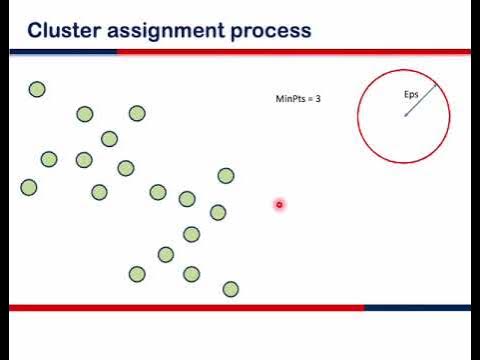DBSCAN (Density Based Spatial Clustering Of Applications with Noise) ll Machine Learning (Hindi)
Summary
TLDRIn this video, the presenter dives into the concept of density-based clustering algorithms, specifically DBSCAN, explaining how it groups data points based on their proximity and density. Key concepts like core points, the epsilon radius, and the minimum points required to form a cluster are discussed in detail. The video also emphasizes the importance of these algorithms in identifying patterns in large datasets, with a focus on the practical application and the robustness of DBSCAN in handling noise. Viewers are given insights into how clusters are formed and how to evaluate the relevance of data points.
Takeaways
- 😀 The video discusses a complex topic related to clustering algorithms, specifically focusing on density-based clustering and the importance of density parameters in identifying clusters.
- 😀 Density refers to how close the data points are to each other in a given area. Higher density means points are closer together, and lower density means they are spread out.
- 😀 The video introduces the concept of the epsilon parameter, which represents the radius of a circle around a data point, used to calculate density.
- 😀 It explains how a minimum number of points, usually three or more, are required within a given area for it to be considered a valid cluster.
- 😀 The importance of core points in clustering is highlighted, where a core point is one that has enough points around it to form a cluster.
- 😀 The script emphasizes how density-based algorithms are robust in identifying clusters even when some points are outliers or noise.
- 😀 The video demonstrates how to calculate the distance between data points and form a circle (with a defined radius) to measure density.
- 😀 An algorithm will identify the cluster center and expand it to include surrounding points that meet the density requirement.
- 😀 Points can either be core points, border points, or noise points based on their relationship with other points in the cluster.
- 😀 The video stresses the importance of understanding how clusters are formed through density and how algorithms can distinguish between relevant and irrelevant data points.
Q & A
What is the main topic of the video?
-The video discusses a specific clustering algorithm, focusing on density-based clustering, its significance, and the concept of core points, along with practical applications in the context of clustering algorithms.
What does the term 'density' refer to in the context of clustering?
-Density in clustering refers to the concentration of data points in a given area. The higher the number of points in a region, the greater the density, and vice versa.
What are the key parameters in density-based clustering algorithms?
-The key parameters mentioned in the video are epsilon (ε), which refers to the radius or distance around a core point, and the minimum number of points required to form a valid cluster.
How is a 'core point' defined in density-based clustering?
-A core point is a point that has a minimum number of neighboring points within a specified radius (epsilon). If a point satisfies this condition, it becomes the center of a cluster.
What is the significance of the epsilon parameter in clustering?
-Epsilon determines the radius around a point within which other points are considered neighbors. It plays a crucial role in defining the density of the cluster and helps in identifying core points.
What happens if a point doesn't meet the minimum density requirement?
-If a point doesn't meet the minimum density requirement (e.g., having enough points within the epsilon radius), it is not considered a core point and may be classified as a noise or outlier.
What is the role of a 'border point' in clustering?
-A border point is a point that is not a core point but falls within the epsilon radius of a core point. It helps expand the cluster, but it doesn't have enough neighbors to be a core point itself.
Can density-based clustering handle noise and outliers?
-Yes, density-based clustering is capable of handling noise and outliers by classifying points that don't meet the density criteria as noise, thus preventing them from interfering with the clustering process.
How does the video explain the concept of a 'directly density-reachable' point?
-A point is 'directly density-reachable' if it falls within the epsilon radius of a core point. This concept is used to identify which points belong to the same cluster based on density connectivity.
What is the significance of identifying core points and border points in the clustering process?
-Identifying core points and border points is essential because they help in forming clusters. Core points form the center of a cluster, while border points expand the cluster, and points that don't meet the criteria are considered outliers.
Outlines

このセクションは有料ユーザー限定です。 アクセスするには、アップグレードをお願いします。
今すぐアップグレードMindmap

このセクションは有料ユーザー限定です。 アクセスするには、アップグレードをお願いします。
今すぐアップグレードKeywords

このセクションは有料ユーザー限定です。 アクセスするには、アップグレードをお願いします。
今すぐアップグレードHighlights

このセクションは有料ユーザー限定です。 アクセスするには、アップグレードをお願いします。
今すぐアップグレードTranscripts

このセクションは有料ユーザー限定です。 アクセスするには、アップグレードをお願いします。
今すぐアップグレード5.0 / 5 (0 votes)






